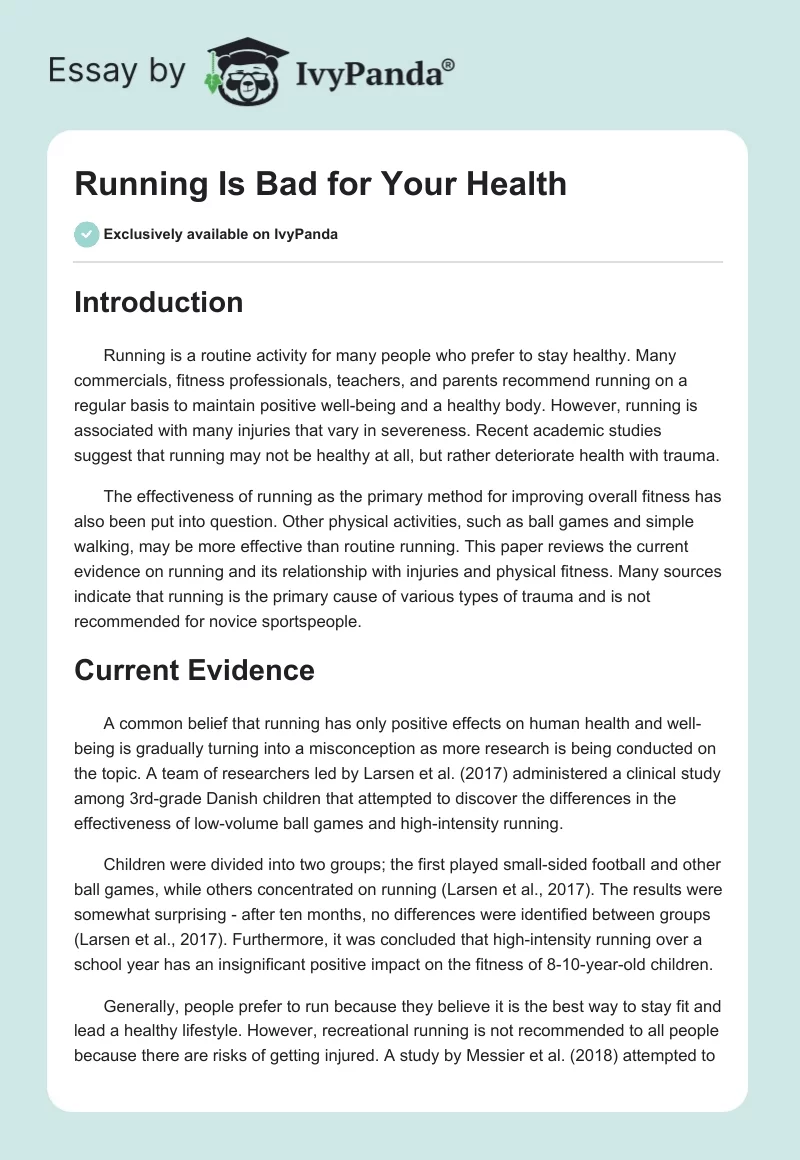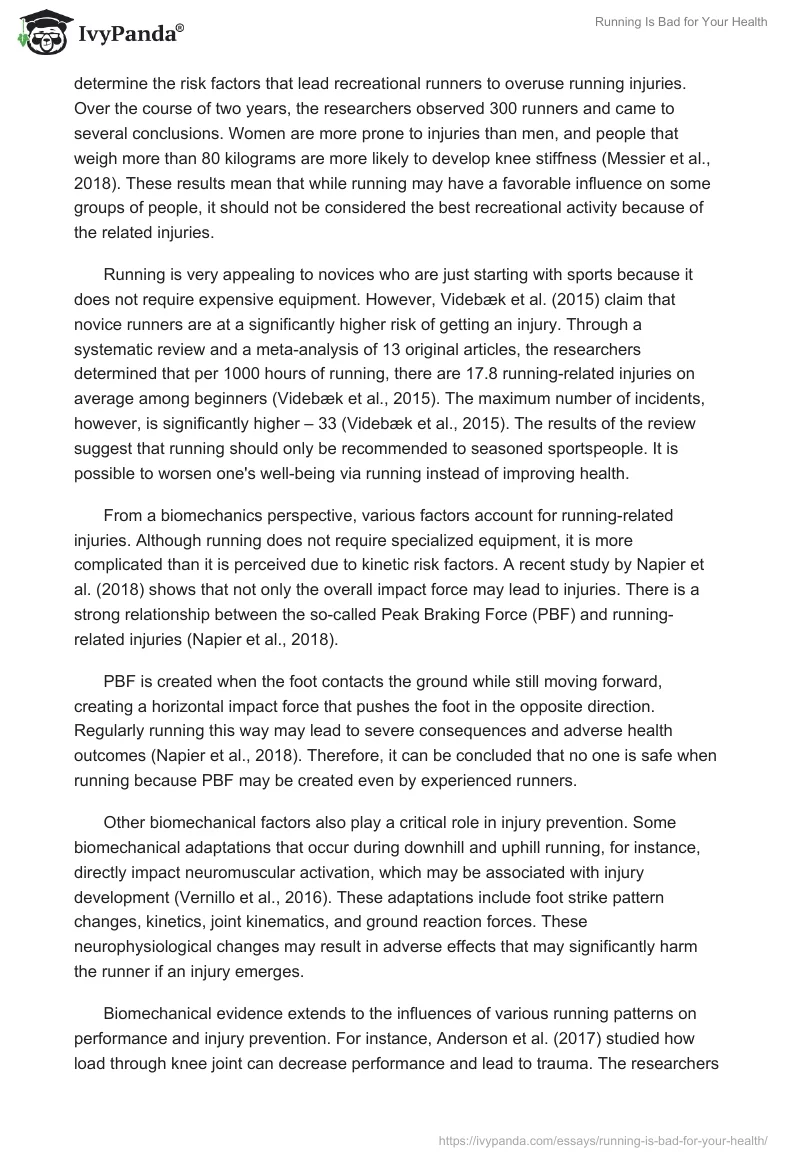Introduction
Running is a routine activity for many people who prefer to stay healthy. Many commercials, fitness professionals, teachers, and parents recommend running on a regular basis to maintain positive well-being and a healthy body. However, running is associated with many injuries that vary in severeness. Recent academic studies suggest that running may not be healthy at all, but rather deteriorate health with trauma.
The effectiveness of running as the primary method for improving overall fitness has also been put into question. Other physical activities, such as ball games and simple walking, may be more effective than routine running. This paper reviews the current evidence on running and its relationship with injuries and physical fitness. Many sources indicate that running is the primary cause of various types of trauma and is not recommended for novice sportspeople.
Current Evidence
A common belief that running has only positive effects on human health and well-being is gradually turning into a misconception as more research is being conducted on the topic. A team of researchers led by Larsen et al. (2017) administered a clinical study among 3rd-grade Danish children that attempted to discover the differences in the effectiveness of low-volume ball games and high-intensity running.
Children were divided into two groups; the first played small-sided football and other ball games, while others concentrated on running (Larsen et al., 2017). The results were somewhat surprising – after ten months, no differences were identified between groups (Larsen et al., 2017). Furthermore, it was concluded that high-intensity running over a school year has an insignificant positive impact on the fitness of 8-10-year-old children.
Generally, people prefer to run because they believe it is the best way to stay fit and lead a healthy lifestyle. However, recreational running is not recommended to all people because there are risks of getting injured. A study by Messier et al. (2018) attempted to determine the risk factors that lead recreational runners to overuse running injuries. Over the course of two years, the researchers observed 300 runners and came to several conclusions. Women are more prone to injuries than men, and people that weigh more than 80 kilograms are more likely to develop knee stiffness (Messier et al., 2018). These results mean that while running may have a favorable influence on some groups of people, it should not be considered the best recreational activity because of the related injuries.
Running is very appealing to novices who are just starting with sports because it does not require expensive equipment. However, Videbæk et al. (2015) claim that novice runners are at a significantly higher risk of getting an injury. Through a systematic review and a meta-analysis of 13 original articles, the researchers determined that per 1000 hours of running, there are 17.8 running-related injuries on average among beginners (Videbæk et al., 2015). The maximum number of incidents, however, is significantly higher – 33 (Videbæk et al., 2015). The results of the review suggest that running should only be recommended to seasoned sportspeople. It is possible to worsen one’s well-being via running instead of improving health.
From a biomechanics perspective, various factors account for running-related injuries. Although running does not require specialized equipment, it is more complicated than it is perceived due to kinetic risk factors. A recent study by Napier et al. (2018) shows that not only the overall impact force may lead to injuries. There is a strong relationship between the so-called Peak Braking Force (PBF) and running-related injuries (Napier et al., 2018).
PBF is created when the foot contacts the ground while still moving forward, creating a horizontal impact force that pushes the foot in the opposite direction. Regularly running this way may lead to severe consequences and adverse health outcomes (Napier et al., 2018). Therefore, it can be concluded that no one is safe when running because PBF may be created even by experienced runners.
Other biomechanical factors also play a critical role in injury prevention. Some biomechanical adaptations that occur during downhill and uphill running, for instance, directly impact neuromuscular activation, which may be associated with injury development (Vernillo et al., 2016). These adaptations include foot strike pattern changes, kinetics, joint kinematics, and ground reaction forces. These neurophysiological changes may result in adverse effects that may significantly harm the runner if an injury emerges.
Biomechanical evidence extends to the influences of various running patterns on performance and injury prevention. For instance, Anderson et al. (2017) studied how load through knee joint can decrease performance and lead to trauma. The researchers suggest that switching to a non-rearfoot strike pattern may help reduce pressure through the knee joint. However, this switch results in a more significant burden on the ankle and foot, which may cause different damages. The current level of understanding of running-related injuries does not allow for optimum decisions related to running and injury prevention.
While there is evidence that more experienced runners face injuries more infrequently, some damages cannot be prevented even by retraining running a running style. Dunn et al. (2018) conducted a study among 20 uninjured runners to determine whether running retraining has positive effects on biomechanical factors related to lower limb injury. The results are not promising for runners who are training to avoid this kind of trauma – adopting different running styles has no effect on biomechanical attributes associated with lower limb running injury (Dunn et al., 2018). Therefore, some types of trauma are known to be unavoidable, at least for the time being. Any individual that considers running as the best way to stay fit should examine these facts before starting this endeavor.
To avoid injuries, individuals should be physically fit and possess knowledge on what types of trauma may occur and their causes. However, running should not be considered as a way of strengthening the body and improving overall well-being. Johansen et al. (2017) created a survey to investigate the opinions of long-distance and short-distance running athletes and their coaches on what factors are associated with injury development.
Most of the respondents considered ignoring pain to be the primary contributor to injuries and pointed out that high distances lead to reduced muscle strength and trauma (Johansen et al., 2017). The most exciting outcome of the survey, however, is the participants’ response to the question that asks about the recommendations to improve fitness and prevent injuries. None of the athletes and coaches included “Running” as their advice.
Running is a predominant cause of many injuries, even among professional athletes. In challenging and dangerous contact sports, such as Australian Rules football, hamstring injuries mostly emerge not on the pitch and not because of unfortunate contacts with other players, but because of high-speed running during training. Duhig et al. (2016) examined one Australian Football League team for a period of two seasons.
The results of the study show that reducing the high-speed running (HSR) distance may decrease the likelihood of hamstring injury development (Duhig et al., 2016). However, if HSR is a necessity for a required fitness level, gradual increases in the range may help mitigate the adverse effects (Duhig et al., 2016). When even professional athletes suffer from unfavorable impacts of running, amateur runners are more prone to risk.
Running-related injuries occur because of complex processes, and it is necessary to conduct detailed research on the causes. There are many necessary ingredients to understand the nature of running-related injuries and their origins. Nielsen (2016) suggests that academic society should propose an evidence-informed conceptual framework that can use the current evidence to both conduct further studies and use the evidence to treat and prevent running-related injuries effectively. Before the emergence of substantial research and evidence, and new methods of injury prevention, however, running should not be a recommended method for gaining physical fitness.
Conclusion
Further research is needed to determine whether running should be a physical activity that is part of school and university programs. People should also have a better picture of the current state of evidence on running. It is clear that many injuries are caused by this activity. Running is also not as effective in enhancing overall fitness as other methods. However, mainstream propaganda of running as a state of art fitness venture led to a public perception of running as a positive and healthy endeavor. Schools and other educational facilities should provide more accurate information so that people do not consider running as the best way to stay fit. In some cases, running could be dangerous to human health because some severe injuries are a direct result of this sport.
Reference List
Anderson, L., Barton, C., and Bonanno, D. (2017) ‘The effect of foot strike pattern during running on biomechanics, injury and performance: A systematic review and meta-analysis,’ Journal of Science and Medicine in Sport, 20(1), p. e54.
Duhig, S., Shield, A. J., Opar, D., Gabbett, T. J., Ferguson, C. and Williams, M. (2016) ‘Effect of high-speed running on hamstring strain injury risk,’ British Journal of Sports Medicine, 50(24), pp. 1536-1540.
Dunn, M. D., Claxton, D. B., Fletcher, G., Wheat, J. S. and Binney, D. M. (2018) ‘Effects of running retraining on biomechanical factors associated with lower limb injury,’ Human Movement Science, 58(1), pp. 21-31.
Johansen, K. K., Hulme, A., Damsted, C., Ramskov, D. and Nielsen, R. O. (2017) ‘Running injury development: the attitudes of middle-and long-distance runners and their coaches,’ International Journal of Sports Physical Therapy, 12(4), pp. 634-641.
Larsen, M. N., Nielsen, C. M., Ørntoft, C., Randers, M. B., Helge, E. W., Madsen, M., Manniche, V., Hansen, L., Hansen, P. R., Bangsbo, J. and Krustrup, P. (2017) ‘Fitness effects of 10-month frequent low-volume ball game training or interval running for 8-10-year-old school children,’ BioMed Research International, 2017(1), pp. 1-9.
Messier, S. P., Martin, D. F., Mihalko, S. L., Ip, E., DeVita, P., Cannon, D. W., Love, M., Beringer, D., Saldana, S., Fellin, R. E. and Seay, J. F. (2018) ‘A 2-year prospective cohort study of overuse running injuries: The runners and injury longitudinal study (TRAILS),’ The American Journal of Sports Medicine, 46(9), pp. 2211-2221.
Napier, C., MacLean, C. L., Maurer, J., Taunton, J. E. and Hunt, M. A. (2018) ‘Kinetic risk factors of running‐related injuries in female recreational runners,’ Scandinavian Journal of Medicine & Science in Sports, 28(10), pp. 2164-2172.
Nielsen, R. (2019) ‘Running injury prevention and treatment viewed from a causal lens: time to consider sudden changes?’ Journal of Science and Medicine in Sport, 22(2), p. S3.
Vernillo, G., Giandolini, M., Edwards, W. B., Morin, J. B., Samozino, P., Horvais, N. and Millet, G. Y. (2017) ‘Biomechanics and physiology of uphill and downhill running,’ Sports Medicine, 47(4), pp. 615-629.
Videbæk, S., Bueno, A. M., Nielsen, R. O. and Rasmussen, S. (2015) ‘Incidence of running-related injuries per 1000 h of running in different types of runners: A systematic review and meta-analysis,’ Sports Medicine, 45(7), pp. 1017-1026.


